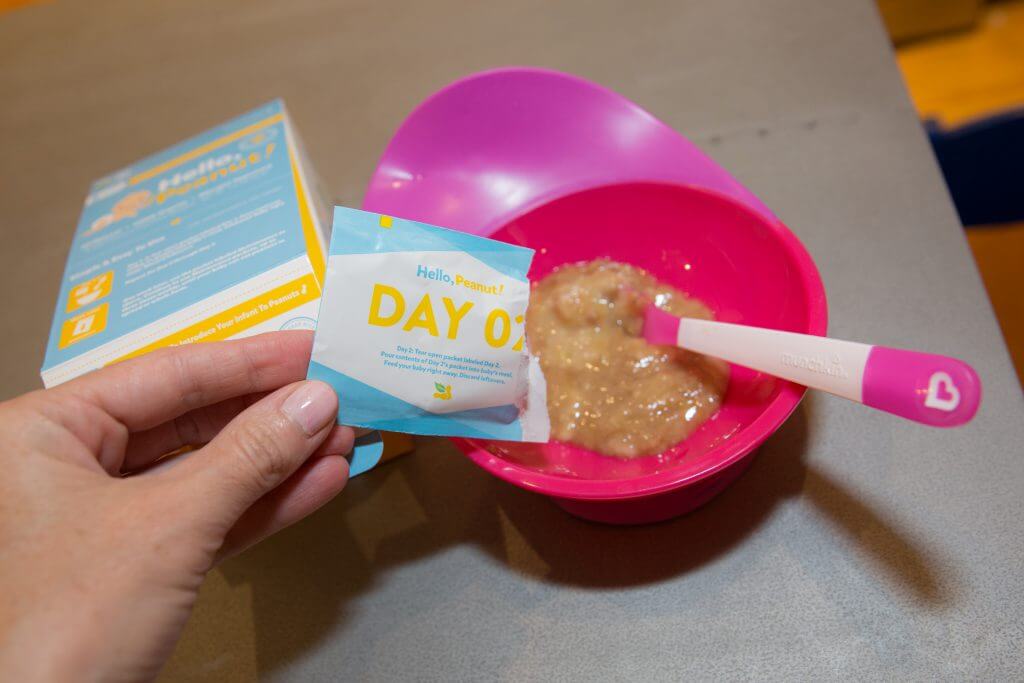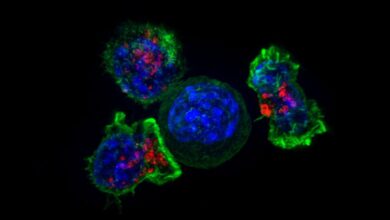
Monthly injection could help children with peanut allergies, offering a potential new approach to managing this serious condition. Peanut allergies affect millions of children worldwide, often leading to severe reactions and impacting their quality of life. Current treatment options, while helpful, can be limited. This new injection method, if successful, could dramatically improve outcomes and provide a more comprehensive solution.
It’s a complex area, involving potential benefits, risks, and ethical considerations.
This in-depth look explores the mechanisms behind this potential treatment, examining the scientific basis, potential benefits and risks, and comparisons with existing approaches. We’ll also delve into the logistical challenges, ethical considerations, and future research directions. Ultimately, understanding this new avenue for managing peanut allergies is crucial for families and healthcare professionals alike.
Introduction to Monthly Injections for Peanut Allergies in Children
Peanut allergies are a significant health concern for children, impacting their daily lives and potentially leading to severe reactions. These allergies often manifest early in childhood and can be triggered by even trace amounts of peanuts. Current treatment options primarily focus on avoidance and emergency preparedness. However, advancements in immunotherapy offer promising alternatives.The current standard of care for peanut allergies involves strict avoidance of peanuts and tree nuts, coupled with the prompt use of epinephrine auto-injectors in case of accidental exposure.
While this approach manages the allergy, it doesn’t address the underlying immune response. Monthly injections, a form of immunotherapy, offer a potential pathway towards modifying this response. This approach aims to desensitize the child’s immune system to peanuts, potentially reducing or eliminating the allergic reaction over time. This method, however, is not without its challenges and must be carefully considered.
Current Treatment Options for Peanut Allergies
Current treatment options for peanut allergies primarily revolve around avoidance and emergency preparedness. Parents and children are advised to strictly avoid all products containing peanuts and tree nuts. This requires careful label reading and diligent monitoring of food sources. Emergency preparedness involves having epinephrine auto-injectors readily available and knowing how to administer them. These measures effectively manage symptoms but do not address the underlying allergy.
Potential Benefits of Monthly Injection Approach
A monthly injection approach, a form of oral immunotherapy, has the potential to modify the child’s immune response to peanuts. The goal is to gradually introduce increasing amounts of peanut protein over time, building tolerance and reducing the likelihood of a severe allergic reaction. Success can lead to a significant reduction in allergy severity or even complete desensitization.
This approach offers a potential pathway toward managing the allergy long-term.
Potential Challenges and Drawbacks of this Treatment Approach
While promising, this approach is not without potential challenges. The treatment often requires a specialized clinic and careful monitoring, potentially adding a significant burden to families. The possibility of adverse reactions, such as mild to severe allergic reactions, exists during treatment. Careful dosage and reaction monitoring are crucial during the treatment process. Furthermore, long-term effectiveness and the potential for the allergy to return after discontinuation of treatment are factors that need to be carefully considered.
Comparative Analysis of Treatment Approaches
| Treatment Type | Mechanism of Action | Advantages | Disadvantages |
|---|---|---|---|
| Strict Avoidance | Preventing exposure to peanuts and tree nuts. | Relatively easy to implement initially, can be effective in preventing reactions. | Requires significant vigilance, can be challenging to maintain long-term, and doesn’t address the underlying immune response. |
| Epinephrine Auto-injectors | Providing immediate relief from allergic reactions. | Essential for managing acute reactions, can potentially save lives. | Does not prevent the allergy, only treats the symptoms. Requires prompt administration and awareness of potential side effects. |
| Monthly Injections (Oral Immunotherapy) | Gradually introducing increasing amounts of peanut protein to desensitize the immune system. | Potential for long-term management or even cure of the allergy. | Requires specialized clinics, careful monitoring, and potential for adverse reactions. Long-term effectiveness and potential for recurrence after discontinuation need further research. |
Mechanism of Action and Scientific Basis

Monthly injections for peanut allergies in children represent a promising avenue for treatment, but the exact mechanisms underlying their effectiveness are still being investigated. While the concept of desensitization is well-established in allergy management, the precise immunological pathways targeted by these injections require further exploration. Understanding these intricate processes is crucial for optimizing treatment protocols and predicting patient responses.
Potential Mechanisms of Action
The hope behind monthly injections lies in modulating the immune system’s response to peanuts. One potential mechanism involves inducing tolerance, where the body learns to coexist with the allergen without triggering an allergic reaction. This could involve shifting the balance between the immune cells involved in allergic responses (e.g., Th2 cells) and those involved in immune regulation (e.g., T regulatory cells).
Another potential mechanism centers on reducing the inflammatory response triggered by peanuts, thereby minimizing the severity of allergic reactions. This could involve reducing the release of histamine and other inflammatory mediators. Ultimately, the goal is to achieve a state where the immune system no longer perceives peanuts as a threat.
Monthly injections showing promise in helping children with peanut allergies is exciting news. While exploring alternative approaches, it’s also important to consider dietary changes, like whether a grain-free diet is truly beneficial for overall health. Digging deeper into the topic of is a grain free diet healthy can provide valuable insight, but ultimately, these new injection treatments could offer a significant step forward in managing peanut allergies for kids.
Immunological Processes in Peanut Allergy
Peanut allergy arises from an aberrant immune response to peanut proteins. Normally, the immune system identifies harmless substances as innocuous. In peanut allergy, however, the immune system mistakenly identifies peanut proteins as harmful invaders. This misidentification triggers the production of IgE antibodies, which bind to mast cells and basophils. When peanut proteins encounter these antibody-coated cells, they release inflammatory mediators like histamine, leading to the characteristic symptoms of an allergic reaction.
So, monthly injections could potentially help kids with peanut allergies, a fascinating development. It’s interesting to see how this aligns with the recent study finding the best approach for people with depression to shed those extra pounds. This study highlights the multifaceted challenges in weight management, especially when mental health is a factor. Regardless, the progress in finding solutions for peanut allergies is promising, and hopefully this leads to a wider range of effective treatments.
Biological Pathways Involved
The immune system employs a complex network of pathways in its response to peanut proteins. The initial recognition of peanuts involves antigen-presenting cells (APCs), which process and present peanut proteins to T cells. Different types of T cells (e.g., Th2 cells) are involved in the allergic response, leading to the production of IgE antibodies. Conversely, T regulatory cells (Tregs) play a crucial role in suppressing immune responses.
The precise interplay between these pathways and the effect of monthly injections on their activity are under active investigation.
Scientific Evidence and Refinement of the Approach
Current scientific evidence suggests that monthly injections have the potential to modulate the immune system and reduce allergic reactions. Studies have shown promising results in some cases, although larger, controlled trials are necessary to solidify the efficacy and safety of this approach. Furthermore, the specific peanut protein components used in the injections and the optimal dosage schedule need further refinement.
Table: Potential Mechanism of Monthly Injections
| Injection Component | Target Cell | Biological Effect | Expected Outcome |
|---|---|---|---|
| Peanut protein extract (possibly specific proteins) | Antigen-presenting cells (APCs), T cells (Th2 and Treg), Mast cells | Altering the immune response to peanuts; inducing tolerance; reducing inflammatory response | Reduced IgE production, decreased activation of mast cells, decreased release of inflammatory mediators, mitigated allergic reactions |
| Adjuvants (potential) | APCs, T cells | Enhance the immune response to peanut proteins | Potentially improved efficacy of the treatment by enhancing the immune response to the target allergens |
| Specific Immunomodulators (potential) | T cells, B cells | Directing immune cells towards a more regulatory phenotype | Reduced allergic response and enhanced tolerance |
Potential Benefits and Risks
Monthly peanut allergy injections offer a novel approach to managing this condition, potentially improving children’s lives significantly. However, like any medical intervention, these injections come with potential benefits and risks that need careful consideration. Understanding these aspects is crucial for informed decision-making for both parents and healthcare providers.This section delves into the potential advantages and disadvantages of this treatment, focusing on potential outcomes for children and their daily lives.
We will examine both the positive impacts on allergic reactions and quality of life, as well as the possible side effects, adverse reactions, and long-term consequences.
Potential Benefits
The primary benefit of monthly peanut allergy injections lies in their potential to reduce the severity and frequency of allergic reactions. This reduction can significantly improve a child’s quality of life, allowing them to participate more fully in daily activities, school, and social interactions. Children with milder reactions may find they can enjoy foods previously avoided without the fear of a severe reaction.
For instance, a child previously restricted from eating peanuts in school lunches could potentially participate more confidently in class activities, such as sharing snacks or eating lunch with classmates.
Potential Risks
While monthly injections hold promise, potential risks need careful attention. Side effects, such as localized pain, swelling, or redness at the injection site, are common with any injectable medication. Serious adverse reactions, although less frequent, are possible. These include systemic allergic reactions, requiring immediate medical attention, or, less frequently, more long-term complications.
Long-Term Consequences
Potential long-term consequences need careful consideration. Data on long-term outcomes are still emerging, but early evidence suggests that children who successfully tolerate these injections might experience a decrease in the need for epinephrine auto-injectors. This could lead to a significant reduction in anxiety related to potential allergic reactions. However, sustained tolerance and a complete eradication of the allergy remain to be seen in the long run.
Impact on School and Social Environments
The impact on a child’s school and social life can be substantial. Reduced allergic reactions can lead to greater participation in classroom activities and social interactions. Conversely, the potential for adverse reactions or injection-related discomfort could create challenges for the child’s daily routine and interaction with peers. For instance, if a child experiences a significant adverse reaction at school, the school’s emergency procedures and staff training become critical factors in managing the situation.
Table of Potential Benefits, Risks, Mitigation Strategies, and Complications
| Benefit | Risk | Mitigation Strategy | Potential Complications |
|---|---|---|---|
| Reduced allergic reactions, improved quality of life | Injection site reactions (pain, swelling, redness) | Careful monitoring by healthcare professionals, adjusting injection techniques | Delayed or incomplete response to treatment |
| Potential for reduced reliance on epinephrine auto-injectors | Systemic allergic reactions (anaphylaxis) | Strict adherence to pre-injection and post-injection monitoring protocols, readily available emergency resources at school | Development of new or unexpected allergic reactions to other foods |
| Increased participation in school and social activities | Long-term unknown consequences | Longitudinal studies and continued monitoring by healthcare professionals | Psychological impact of repeated injections and treatment uncertainties |
Comparison with Existing Treatments

The proposed monthly injection approach for peanut allergy treatment in children presents a novel alternative to existing methods. Understanding how it stacks up against current options is crucial for evaluating its potential impact on patient care. This comparison delves into the strengths and weaknesses of each approach, highlighting potential advantages and drawbacks for patients and healthcare providers.
Oral Immunotherapy (OIT)
Oral immunotherapy (OIT) is a well-established treatment for peanut allergy. It involves gradually introducing increasing amounts of peanut protein to the patient’s diet under strict medical supervision. This process aims to desensitize the immune system over time, reducing the risk of severe allergic reactions. This gradual exposure is a key component, allowing the body to adapt and potentially develop tolerance.
- Target Symptoms: OIT aims to reduce the severity and frequency of allergic reactions to peanuts, including symptoms like hives, swelling, difficulty breathing, and anaphylaxis.
- Efficacy: OIT has proven efficacy in many cases, demonstrating a significant reduction in allergic reactions for many individuals. However, the effectiveness can vary considerably depending on factors like the patient’s age, the severity of their allergy, and the specific protocol followed.
- Potential Side Effects: OIT carries the risk of immediate allergic reactions, such as hives, itching, and swelling. These reactions are typically managed with pre-emptive medication and immediate treatment protocols. Long-term effects, while less common, are still a concern, and ongoing monitoring is crucial.
Subcutaneous Immunotherapy (SCIT)
Subcutaneous immunotherapy (SCIT) involves administering gradually increasing doses of allergen extracts, such as peanut extract, under the skin. Similar to OIT, it aims to build tolerance and reduce the body’s allergic response. SCIT is often used for other allergies, but it’s less commonly used for peanut allergies.
- Target Symptoms: SCIT targets reducing the severity and frequency of allergic reactions to peanuts, including symptoms like hives, swelling, difficulty breathing, and anaphylaxis.
- Efficacy: The efficacy of SCIT for peanut allergies is not as well-established or studied as OIT, and its success can vary considerably.
- Potential Side Effects: SCIT carries the risk of localized reactions at the injection site, such as redness, swelling, and pain. More severe systemic reactions, while less frequent, are possible. A careful monitoring process is vital during treatment.
Monthly Injection Approach
This new approach involves administering a carefully calibrated dose of peanut protein via injection on a monthly schedule. The goal is to induce a gradual desensitization response in a more concentrated and controlled manner.
- Target Symptoms: The monthly injection approach aims to reduce the severity and frequency of allergic reactions to peanuts, including symptoms like hives, swelling, difficulty breathing, and anaphylaxis. The goal is to achieve long-term tolerance.
- Efficacy: The efficacy of this monthly injection approach is currently under investigation. Early research suggests promising results, potentially offering a more efficient approach to desensitization compared to OIT. However, more extensive clinical trials are needed to fully evaluate its long-term effectiveness.
- Potential Side Effects: As with other immunotherapy approaches, potential side effects include injection site reactions and systemic allergic reactions. Careful monitoring and appropriate management of potential reactions are essential.
Comparison Table
| Treatment Type | Target Symptoms | Efficacy | Potential Side Effects |
|---|---|---|---|
| Oral Immunotherapy (OIT) | Reduces allergic reactions to peanuts | Proven efficacy, but variable results | Immediate allergic reactions, long-term effects |
| Subcutaneous Immunotherapy (SCIT) | Reduces allergic reactions to peanuts | Less established efficacy than OIT | Local and systemic reactions |
| Monthly Injection Approach | Reduces allergic reactions to peanuts | Early research shows promise, further investigation needed | Injection site reactions, systemic allergic reactions |
Potential Challenges and Future Directions
The prospect of a monthly injection for peanut allergies in children is exciting, but it’s crucial to acknowledge the potential hurdles in implementation and research needed to refine this treatment. Addressing logistical concerns, expanding research, and ensuring accessibility are paramount for this potentially life-altering therapy.The path forward requires careful consideration of the challenges ahead and a proactive approach to future research to maximize the benefits and minimize the risks.
Logistical Challenges in Implementation
Implementing a monthly injection program for a large population requires careful planning. Supply chain management, ensuring consistent medication quality, and training healthcare professionals to administer the injections effectively are critical logistical hurdles. The need for reliable refrigeration and storage, especially in regions with limited access to advanced medical infrastructure, presents another significant hurdle. Proper disposal procedures must also be considered for safe medication handling.
Research Areas for Efficacy and Safety
Further research is needed to evaluate the long-term efficacy and safety of the monthly injection. Studies focusing on different age groups, varying peanut sensitivities, and potential interactions with other medications are crucial. Research should also explore the potential for treatment adaptation based on individual patient responses. Observing the impact on the development of the immune system over time, especially in the long-term, is vital for comprehensive safety assessment.
Accessibility and Cost
The accessibility and cost of the monthly injection are crucial considerations. Ensuring equitable access to this treatment, particularly for children in underserved communities, is essential. The potential cost of the injection, coupled with potential side effects or complications, may affect the affordability of this treatment for some families. A thorough cost-benefit analysis, including potential long-term savings from reduced allergy-related healthcare costs, is necessary to support the economic feasibility of this approach.
Impact on the Pharmaceutical Industry
The development of a monthly injection for peanut allergies will undoubtedly impact the pharmaceutical industry. It could lead to new business models focused on preventative care, potentially changing the way companies design and market allergy medications. A monthly injection could also encourage research and development of similar long-acting therapies for other conditions, pushing the boundaries of preventative medicine.
Research Areas to Explore
- Long-term safety studies: Evaluating the long-term impact of the monthly injections on various aspects of the child’s health, including the development of the immune system and potential side effects.
- Comparative effectiveness: Comparing the efficacy of the monthly injection to existing treatments, including oral immunotherapy, to identify optimal treatment strategies.
- Personalized treatment approaches: Developing algorithms and strategies to tailor the injection schedule and dosage based on individual patient responses and factors such as age, severity of allergy, and genetic predisposition.
- Cost-effectiveness analysis: Determining the long-term cost-effectiveness of the monthly injection compared to existing treatments, taking into account potential healthcare savings and other societal factors.
- Global accessibility: Exploring solutions to ensure equitable access to the treatment in various regions, addressing potential logistical and financial barriers.
Ethical Considerations
Monthly injections for peanut allergies in children present a complex web of ethical considerations. Balancing the potential life-saving benefits with the inherent risks and uncertainties requires careful scrutiny. This necessitates a deep dive into informed consent procedures, societal impacts, and the application of ethical frameworks to guide the development and implementation of such a treatment.
Informed Consent and Parental Involvement
Obtaining informed consent for a novel treatment like monthly injections is paramount. Parents must fully understand the potential benefits, risks, and alternatives. This necessitates clear, comprehensive, and age-appropriate communication. Detailed information about the injection’s mechanism, potential side effects, and long-term implications should be presented in a manner that facilitates informed decision-making. It’s crucial to acknowledge the emotional burden parents face when considering treatment options for their children’s allergies.
Open channels of communication and support systems are essential to ensure informed consent is not just a formality but a genuine process of shared understanding and decision-making. Parental involvement must extend beyond the initial consent phase; ongoing communication and feedback mechanisms are vital to ensure the treatment’s efficacy and safety are being monitored.
Ethical Frameworks
Various ethical frameworks can guide the development and implementation of this treatment. Utilitarianism, focusing on maximizing overall benefit, can weigh the potential societal impact against individual risks. Deontology, emphasizing moral duties and rights, necessitates respecting the child’s autonomy as they mature and understanding the rights of the child and their parents to make informed decisions. Virtue ethics, focusing on character and moral excellence, encourages practitioners to act with compassion, integrity, and responsibility throughout the process.
Each framework provides a lens through which to assess the treatment’s ethical implications.
Societal Impact
The societal impact of this treatment extends beyond individual families. Access to the treatment, its cost-effectiveness, and potential for long-term societal health improvements are critical considerations. The treatment’s success could dramatically reduce the burden of peanut allergies, leading to decreased healthcare costs and improved quality of life for affected children and their families. However, potential disparities in access based on socioeconomic factors must be anticipated and addressed.
Policies and programs must be developed to ensure equitable access for all children, regardless of their background or location.
Exciting news about monthly injections potentially helping children with peanut allergies! While there’s no permanent cure for conditions like atrial fibrillation, this new avenue of treatment could significantly improve the lives of those affected. This development, however, is still in the early stages and much more research is needed before widespread use. Ultimately, these monthly injections could be a game-changer for children with peanut allergies, providing a powerful new tool to manage their condition.
no permanent cure for atrial fibrillation is a stark reminder that many medical conditions, while treatable, still require ongoing management.
Ethical Considerations Table
| Ethical Issue | Stakeholder Impact | Mitigation Strategy | Potential Conflicts |
|---|---|---|---|
| Informed Consent | Parents, children (as they mature), healthcare providers | Clear, comprehensive, and age-appropriate communication; culturally sensitive materials; support systems; ongoing communication | Difficulty in fully explaining complex medical procedures; potential for coercion; conflicting parental desires; balancing child’s autonomy with parental rights |
| Equity of Access | Children from low-income families; marginalized communities | Financial assistance programs; subsidies; community outreach; ensuring equal access to information and support; strategic location of clinics | Limited resources; bureaucratic hurdles; logistical challenges in reaching all populations |
| Long-term Effects | Children, future generations, society | Longitudinal studies; continuous monitoring of side effects; ongoing research; transparent reporting | Unpredictable long-term complications; potential for unforeseen side effects; challenges in evaluating the long-term efficacy and safety of the treatment |
| Potential for Overuse | Children without severe allergies; healthcare system | Clear diagnostic criteria; rigorous protocols for treatment; cost-benefit analysis; alternative treatment options | Misdiagnosis; unnecessary medical procedures; strain on healthcare resources; ethical dilemmas regarding the allocation of limited resources |
Illustrative Case Studies (Hypothetical)
Exploring the potential of monthly peanut allergy injections in children requires looking at real-world scenarios, even if they are hypothetical. These examples help us understand the treatment’s potential benefits, risks, and the challenges involved in managing such a complex condition. We will examine the course of treatment, outcomes, and lessons learned from each case.
Hypothetical Case Studies
These case studies provide illustrative scenarios, not real patient data. They aim to highlight the potential benefits and risks of monthly peanut allergy injections, the challenges encountered, and the effectiveness of the treatment.
Case Study 1: Early Intervention and Gradual Desensitization, Monthly injection could help children with peanut allergies
A 6-year-old, Leo, has a moderate peanut allergy. He experiences mild reactions to accidental exposures. He is enrolled in a clinical trial for monthly injections. The treatment plan involves gradually increasing the dose of peanut extract over several months. Leo demonstrates a positive response, with reduced sensitivity to peanut protein.
He continues to be monitored for any adverse reactions. Challenges include potential delayed or unexpected reactions, which require careful management. The treatment shows promise in reducing allergic reactions, but long-term effectiveness and potential for breakthrough reactions require further monitoring.
Case Study 2: Late Diagnosis and High-Severity Reactions
A 10-year-old, Maya, presents with a severe peanut allergy. She has experienced life-threatening anaphylactic reactions. Monthly injections are introduced, but Maya exhibits more frequent and intense reactions. The treatment plan involves cautious titration of the dosage, and the addition of epinephrine auto-injectors and strict avoidance measures. Challenges include managing the fear and anxiety associated with potential reactions.
The treatment’s effectiveness is limited in this case, requiring a multi-pronged approach, including continued avoidance and emergency preparedness. The effectiveness of the treatment is uncertain, but the treatment plan’s primary aim is to manage severe reactions.
Case Study 3: Variable Responses and Long-Term Outcomes
An 8-year-old, Noah, has a mild peanut allergy. He initially responds well to the monthly injections, with a significant reduction in sensitivity. However, over time, his response fluctuates. The treatment plan necessitates frequent adjustments to the dosage and close monitoring. Challenges include predicting and adapting to unpredictable responses.
The treatment demonstrates efficacy in certain cases, but the need for individualized treatment plans and continued long-term monitoring is highlighted.
Effectiveness and Limitations Table
| Patient Profile | Treatment Plan | Outcome | Lessons Learned |
|---|---|---|---|
| Leo (6 years, moderate allergy) | Gradual increase in peanut extract dose over months | Reduced sensitivity, positive response | Treatment shows promise but requires continuous monitoring for delayed reactions. |
| Maya (10 years, severe allergy) | Cautious titration of dosage, epinephrine auto-injectors, avoidance | Limited effectiveness, frequent reactions | Multi-pronged approach, including avoidance, is essential for managing severe allergies. |
| Noah (8 years, mild allergy) | Initial positive response, fluctuating sensitivity over time | Variable response, requires frequent adjustments | Individualized treatment plans and long-term monitoring are crucial for variable responses. |
Concluding Remarks: Monthly Injection Could Help Children With Peanut Allergies
In conclusion, the potential of monthly injections for managing peanut allergies in children is significant. While promising, many hurdles remain. Rigorous research, careful consideration of ethical implications, and a focus on accessibility are paramount. This new approach, if proven safe and effective, could revolutionize the treatment of peanut allergies, potentially offering a safer and more comprehensive solution for children and their families.


